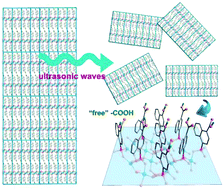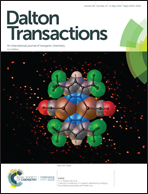Polymorphic layered copper phosphonates: exfoliation and proton conductivity studies†
Abstract
Three polymorphic copper carboxylate-phosphonates are reported, namely, α-Cu(4-cnappH)(H2O) (α-Cu-1), α-Cu(4-cnappH)(H2O)·0.5H2O (α-Cu-2) and β-Cu(4-cnappH)(H2O) (β-Cu), where 4-cnappH3 is (4-carboxynaphthalen-1-yl)phosphonic acid. All show layer structures but with different layer topologies. The layer topologies of the α-phases are similar, where the distorted {CuO4} planes and {PO3C} tetrahedra are corner-shared forming an inorganic layer containing 8- and 16-member rings. In β-Cu, double chains made up of corner-sharing {CuO5} and {PO3C} are crossed-linked through edge-sharing of the {CuO5} square pyramids to form an inorganic layer containing 4- and 8-member rings. The uncoordinated carboxylate groups are protonated and are involved in the interlayer hydrogen bonds in all cases. Antiferromagnetic interactions are dominant in all cases. Compounds α-Cu-1, α-Cu-2 and β-Cu can be exfoliated in THF resulting in 2D nanosheets of mainly two-layer thickness. Proton conductivity measurements reveal that the proton conduction is more favorable in α-Cu-2 than in α-Cu-1, but exfoliation into nanosheets decreases the conductivity.



 Please wait while we load your content...
Please wait while we load your content...